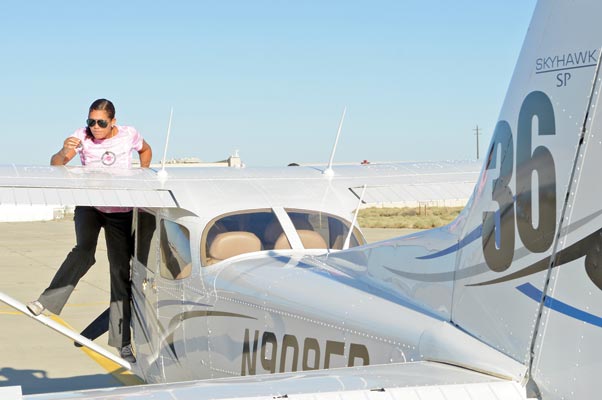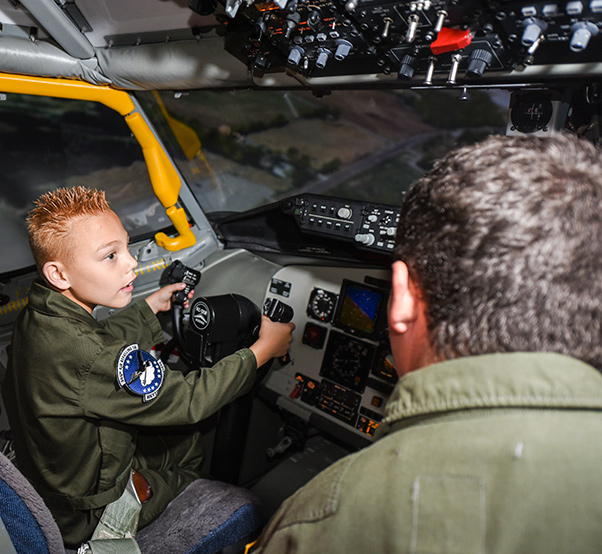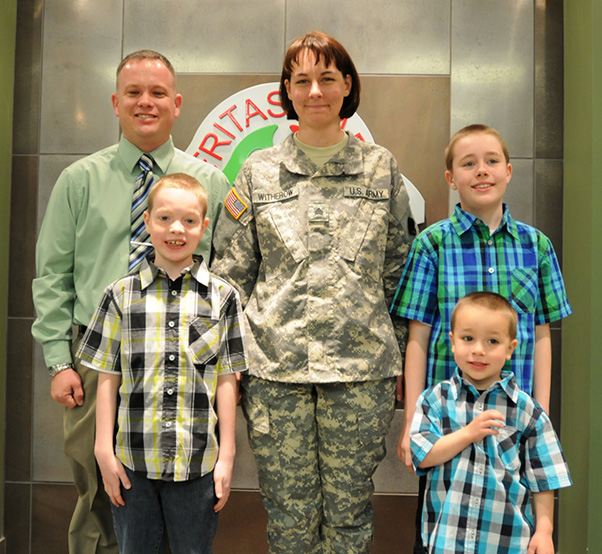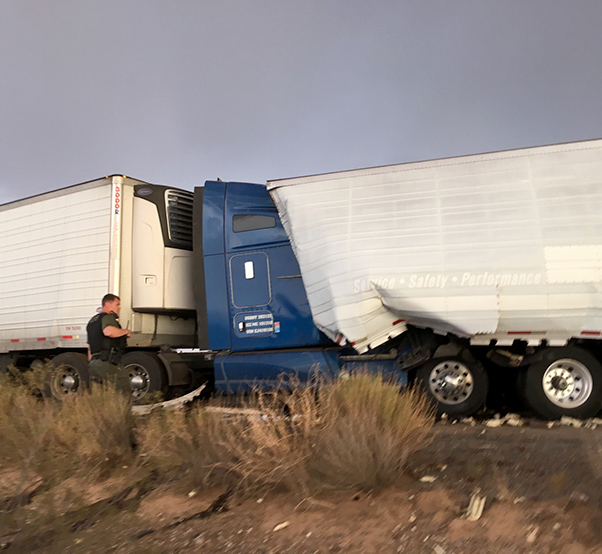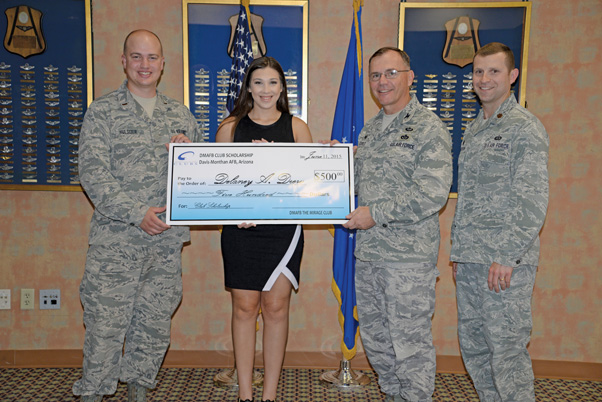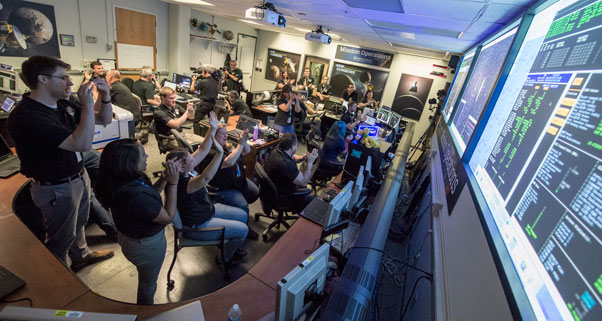Female aviators and air races in the U.S. have a rich history dating back to 1929, which originally started as the Women’s Air Derby and included a field of 20 female pilots that included renowned aviatresses such as Amelia Earhart, Pancho Barnes and Louise Thaden.
For one 461st Flight Test Squadron engineer working on the F-35 Joint Strike Fighter, and Edwards Aero Club member and pilot, Nancy Bradshaw decided to become part of that legacy by competing in the 39th Annual Air Race Classic, an all-women air race, which took place June 22-25, 2015.
“It’s amazing to say that we participated in what all the greats did, especially with the legacy Pancho Barnes has here at Edwards. These women all paved the way,” said Bradshaw. “For us, this race was a lot easier, especially with all the modern avionics, then it was for the women back then. If you look at all the photos, research the history of how they flew back then, they were flying without digital instruments, with paper maps, looking out for visual landmarks. Even though the planning part is different now, it was still amazing, nonetheless, to be able to participate in such an
historic event.”
Together with co-pilot Anita Mixon, from West Palm Beach, Fla., they flew a Cessna 172 equipped with a G1000 glass cockpit with tail number N909ED, rented from the Edwards AFB Aero Club. According to Bradshaw, this year’s 2,529 statute-mile race began in Fredericksburg, Va.; with stops in Hickory, N.C.; Connellsville, Penn.; Jeffersonville, Ind.; Kalamazoo, Mich.; Lawrenceville, Ill.; Kirksville, Mo., Union City, Tenn.; Gadsden, Ala.; with the terminus in Fairhope, Ala.
“I’ve always wanted to fly in this air race and since the Aero Club is located on base not far from my work place, I wanted to start my training here. Since I also want to be a flight instructor and I’ve done all my flight training here in the Antelope Valley, I know everything about flying in nice California weather and the Los Angeles Basin, but nothing about the rest of the country,” Bradshaw said. “This race was a perfect opportunity to actually fly to the other side of the country and experience everything else in between, especially when it came to weather. There was a lot of bad weather I encountered along the way and things we normally don’t see on this side of the country.”
Although Bradshaw noted that the race was truly one of the most intense and challenging flying experiences she’s had, she said getting there was equally challenging.
“First, I had to fly solo from Edwards AFB across the country to the start line in Fredericksburg, which was a really great experience to be flying solo in the aircraft because you normally fly with someone. It took six days due to less-than-ideal weather conditions, stopping at 10 airports and flying a total of 2,384.42 statute miles. I was extremely thankful that I received my instrument rating here because it really paid off during the trip because I had to fly actual instrument time by myself.
In addition to the challenge of flying cross country, she said there were other factors that contributed to this formidable flight experience that required her to take all her training and apply it along the way.
“Once in Virginia, I met up with my co-pilot who I’d never met until the race, which could’ve proven to be interesting, since you’re flying with some you don’t know for a long period of time in a small aircraft. Despite this, she was a great co-pilot and without her the whole race wouldn’t have gone as well as it did, since we were both first timers in this race,” said Bradshaw.
“One of the biggest challenges was also the time crunch involved with it all. You technically have four days to finish and we finished in three. We’d fly three legs in one day and at the end of the day you’re exhausted, but you still have to plan for the next day. Even though you do flight planning before the whole thing happens, when you’re right then and there, you don’t know how many legs you’re going to do in one day, so you have to take weather, fatigue and multiple factors like tailwinds all into account.”
Another challenging factor Bradshaw noted were the hot temperatures.
“Because you want your airplane to be fast, you lock everything up like the vents so there’s no airflow. In some of the legs, we had bad headwinds so we stayed low to the deck, so it definitely made for an uncomfortable flight.”
At the end of it all, with race number 36, Bradshaw and Mixon completed the course in just three days, placing 38th out of the 47 teams that finished.
“The return to base from Fairhope, Ala., took four days, including one day of visiting the Grand Canyon, six airports, covering 1,790 statute miles,” added Bradshaw. “It was an epic flying adventure across the nation that not only allowed me to gain new skills and become a more confident pilot, but allowed me to meet some great people at each stop along the way.”
The ARC is an annual VFR (good weather) cross-country event flown by airplanes with at least 100 horsepower and not more than 600 horsepower in either a competition or a non-competition class. Competition class includes stock and modified stock, normally aspirated, piston-powered airplanes, rated for continuous operation at maximum engine speed. Non-competition class includes airplanes not qualifying in competition class per ARC rules, and those teams are not racing, but flying the event solely for education and experience. Both classes follow the same rules and enjoy similar flying adventures over the 2,529-mile course.
All entered airplanes are flown for handicap speed before the start. Teams then race their handicap speed, trying to best their own top speed from timing line to timing line. Once the first plane launches they have four days to fly all nine race legs and to arrive and cross the terminus finish line. Thorough knowledge of the rules and route are critical to successful completion of the race.
Two current licensed women pilots compromise a team. Passengers are allowed and they must be women pilots or student pilots. This year, 56 teams were entered in the race and 47 teams finished the course, with women pilots ranging in age from 18 to 88 years old and who come from a wide variety of backgrounds.
For more information about learning to fly at the Aero Club, call 661-275-AERO.


